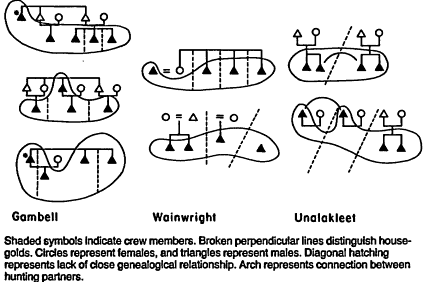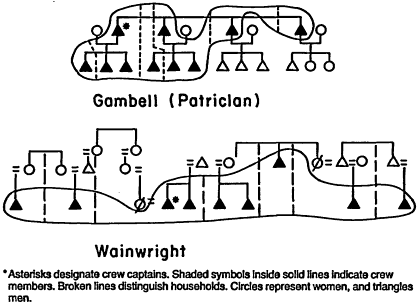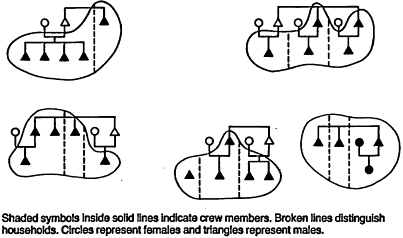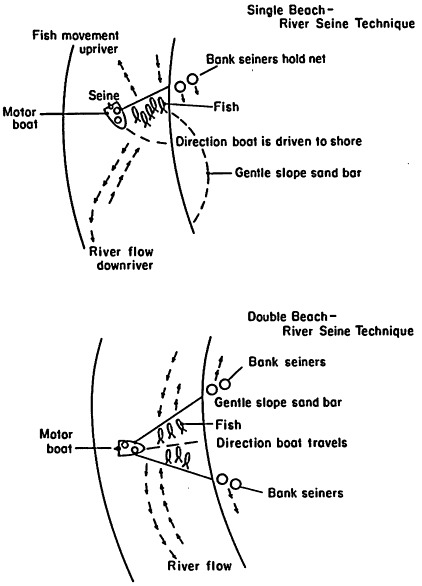The Organization of Labor for Extraction
The harvesting of subsistence resources is commonly carried out in the company of other people in all three Eskimo villages. Hunting by a sole hunter, using the stalking technique, does occur but not frequently. The reasons for forming parties of two or more people are obvious after spending time in and around the villages: safety, companionship, economy, labor assistance, and, very frequently, as occasions to teach youngsters by precept. Hunters sometimes go out by themselves for birds or seals and, in Unalakleet, also for hares. In all of the villages, men will go unaccompanied to check and empty fishnets or to check their trap lines if either or both are set close to town. On occasion, women, alone, will clear the fishnets. But when trips are made over long distances in potentially hazardous conditions to take large and sometimes dangerous game (e.g., walrus or brown bears) or to harvest a resource in quantity (e.g., seining for fish, collecting roe-on-kelp, hunting caribou), the parties vary from two to more than twenty people.
In all three villages, regardless of changes to the economic, educational, social, and religious institutions, kinship-based principles are primary in subsistence pursuits. Most of the task groups that are concerned with subsistence activities are composed of cores of kinspersons. Friends and affines, too, may join the parties on regular or ad hoc bases. Most of the sharing of
skills, equipment, and resources—including catch, bag, quarry, and collection—is conceived as occurring among kinspersons. And the natives in all three villages claim, and exercise, the tight to subsistence extraction of all kinds, not only because of cultural heritage (they desire to do so) and economic necessity (they must do so to survive) but also because of inheritance: their parents, parents' parents, and earlier ancestors all extracted for subsistence.
Kinship and affinal (in-law) relations loom large in the organization of all forms of extraction in all three villages, and kinship principles are very important in the organization of extraction and distribution. Kinship ties are so central to the organization of daily affairs on St. Lawrence Island that even though the villages of Gambell and Savoonga have divided the island between them, and patriclan members in each village usually extract goods with patrician members from the same village, still they share the results with their kinspersons, regardless of the village in which they reside, including Nome.
The Wainwright and Unalakleet villagers organize themselves for hunting, fishing, and gathering tasks in rather similar ways. They observe bilateral descent and use kinship terminologies that are very similar in type to the American kinship system.[2] When reckoning kinship relations, Eskimos in these villages place equal emphasis on relatives on the mother's side and the father's side. Siblings, cousins, parents, aunts, uncles, children, nephews, nieces, grandparents and in-laws on both sides are treated as kinspersons with whom it is usual to hunt, fish, collect wild plants and birds' eggs, camp, and socialize.
Although whaling is a minor activity in Unalakleet, the whaling crew organizations in these two villages are deeply embedded in their kinship and affinal organizations. In Wainwright, a whaling crew may be made up of a man, his sons, the sons of his wife's siblings or his own siblings and often some in-laws (perhaps his daughters' husbands, his wife's brothers, or the
[2] George Peter Murdock, in his monumental Social Structure (New York: Macmillan, 1949) classified American kinship terminologies as belonging to the "Eskimo" type in which brothers are distinguished from sisters, siblings are distinguished from cousins, and aunts and uncles are distinguished from mother and father.
like). But kinship and affinal relations are complemented by friendships and partnerships as well. In their youth, Unalakleet and Wainwright males often develop deep friendships with peers which last throughout their lives. Boys grow up hunting, fishing, and playing together and continue working together in subsistence tasks, often sharing the fruits of their efforts. They frequently join the same whaling crews, regardless of kinship ties.
The differences in the organization of labor in Gambell, on the one hand, and in Wainwright and Unalakleet, on the other, are apparent. Gambell residents observe principles of patrilineal descent, patrilineal inheritance, and patrilineal succession, whereas Unalakleet and Wainwright are bilaterally organized. Inheritance and succession are much more flexible among the bilateral societies, as are task group organizations.
By "task group" we refer to an organization of three or more people who regularly conduct some subsistence-related task. Neither the core of the group nor the entire group changes m any degree in composition from year to year when engaged in some particular task. Whaling crews, walrus crews, seining groups, and bearded seal hunting groups, among others, form task groups. These groups normally have leaders—persons possessing considerable knowledge about the work to be performed. Task group leaders in all three communities normally are (1) highly regarded because of their skill, (2) generous in sharing the bag, (3) followed out of respect and, often, a desire to learn, and (4) frequently the providers of the major equipment used in the task.
Task groups are often made up of persons engaged in complementary functions, rather than the same function. In fish seining, for example, one person may drive the boat, several may pull the seine taut, some may throw rocks to keep the fish inside the seine, some may butcher and fillet the fish, and some may hang the fillets to dry. Whatever the case may be, the task groups—except in the instances of long and arduous caribou hunts or, perhaps, of hunting expeditions for brown bears—normally have one or more children along, learning by precept and by instruction. They are teaching and learning groups, therefore, as well as extraction groups. The structure and size
of subsistence task groups are also influenced by the resources that are to be extracted, the distance from the villages where the resources will be found, the probable duration of the activity, the technology required by the task, and the time of the year.
The natural and social qualities of men and animals all play a part in the construction of task groups. Wainwright villagers believe that walrus will attack the boat if it contains anyone who came along merely to demonstrate bravery. Since the men in that village do not like to put women in danger, women were formerly restricted from crews. Currently, a few women do hunt with the men, indicating that the villagers have lost sight of the earlier stricture that prohibited women from touching or using mens' tools of the hunt and are also willing to bend their current attitudes about shielding women from the danger of the hunt.
Although other factors are involved, then, kinship principles are usually invoked to recruit the members of the task groups, whereas preferences of families for various resources may also influence what resources will be pursued at various times of the year. Thus, a family's desire for food—a cultural component—influences the tasks and the task group composition. In relation to the latter point, walrus do not constitute a preferred food item in either Unalakleet or Wainwright, and the animals are viewed as dangerous. In these villages, walrus are hunted infrequently, relative to their availability, and usually by crews of men who have hunted together in the past but who do not normally or regularly do so. The crews, or their cores, appear to be composed of "experts at-large." Unalakleet whaling crews also fit this description.
Employment and Subsistence Tasks
At Gambell, walrus is the village's staple as well as a highly preferred food item. Walrus are hunted year-round by crews usually composed of several persons from the same patrician who regularly hunt together. There is much less employment in Gambell than in either Wainwright or Unalakleet, and the organization of the task groups and the frequency with which
crews are on the water—leads in the winter, open in the sum-mer—in pursuit of walrus reflect these several differences.
At Unalakleet, and even more so at Wainwright, people will juggle their jobs with subsistence time. Employed men work to pay for the equipment, supplies, and gasoline that are necessary for the hunt. A walrus crew might, therefore, have a core of hunting partners but be supplemented by one or two available and eager hunters who can spare the time. Often, then, such crews are ad hoc, forming somewhat hastily and leaving the villages after work to hunt walrus only twenty-five or thirty miles from the village. Or they may pursue walrus during weekend hunts, butchering their quarry and returning to town in time to return to their jobs.
Wage work profoundly limits the choices that go into subsistence pursuits. Gambell villagers are least affected by time constraints but most affected by financial constraints among the three villages. Wainwright villagers are most affected by time constraints and least affected by financial constraints. The combination at Gambell encourages the maintenance and interplay of social ties, whereas the combination at Wainwright restricts the interplay of social ties. Wage work exercises less influence on subsistence choices and social ties in Unalakleet than in Wainwright, although there, too, employed persons are limited in their time allocation. In Wainwright and Unalakleet, those who are constrained by job obligations are able to contribute more to the subsistence expenses of the family members who are less constrained.
Hunting Groups
The Lone Hunter
During the winter, lone hunters in the three villages may push sleds onto the rotten ice and pursue seals at their breathing holes and along leads in the ice. Yet even in winter seal hunting, it is common for two men to travel together to the hunting area and to return home together. Caribou often seek winter forage very close to Wainwright, and as a consequence, a lone hunter may pursue them. Here, too, partners often hunt together.
Partners and Small Groups
At Gambell, small hunting groups normally have about four members and are almost always composed of male siblings, a father and his sons, brothers and their sons, or a paternal uncle and his nephews. The size of the Gambell groups reflects, in large part, the nature of the resources that are available to the islanders. Except for polar bears (a marine mammal) and reindeer (a tame land mammal), there are few opportunities to hunt in pairs. Polar bears are a very limited resource, whereas reindeer, a limited and managed resource, must be paid for, much as a hunter from California purchases a deer tag to bag a deer in Utah. And because the reindeer are herded, several men make a joint trip to the herd—managed by their Savoonga clansmen—to hunt the animals.
Hunting partners are characteristic of Unalakleet and Wainwright. Partners are usually closely related men (brothers, cousins, uncle and nephew, father and son). It is also common for hunting partners to be close friends or brothers-in-law. Partners hunt together but also form the cores of slightly larger hunting groups, which may increase to as many as four people for some pursuits.
Flexibility of Partnerships
It is commonplace in both Unalakleet and Wainwright for a man to have two or three hunting partners with whom he hunts for different species or at different times. In these villages, too, partnerships are often established with persons—kinsmen or friends—from other villages. One partner may join the other to hunt as a guest in his territory, or they may make gifts to one another of subsistence foods, or they may be especially hospitable to one another at community festivities.
At Unalakleet and Wainwright, the collective hunting skills known throughout the villages are not shared equally in every family, so that young men sometimes go hunting with experienced elder men, from whom they want to learn more about the animals hunted, the ice and weather conditions, the behavior and sensitivities of various animals, and so forth.
Large Hunting Groups and Crews
Groups larger than partnerships form in Gambell for the great majority of subsistence extraction pursuits including the hunting of walrus, bearded seals, and birds and the collection of birds' eggs and plants of various kinds. These resources constitute a wide variety of differences as to size, amount, access, location, means to harvest, difficulty of transport, and so forth. They are similar in that each type of resource requires rather large crews, and those crews harvest very large quantities of each resource type. Extraction of every one of these resources requires considerable coordination of labor to harvest, butcher (except for eggs), clean, transport, store, and distribute the resources during the short time in which they are available.
The seabird and egg collecting crews have no counterparts in Unalakleet or Wainwright, but walrus, small whale (e.g., beluga), and bearded seal crews are formed in all of the villages.[3] The crews are similar in size and in some other features. Each is usually composed of a captain (who owns the boat and capitalizes the venture), a navigator, a person to keep the lines from being tangled and to release the floats after the animal has been harpooned, and a harpooner. All crewmen beach the prey, pulling it onto an ice floe or onto a beach. The captain directs the butchering and distributes the catch.
The differences are marked. Crews, sometimes consisting of as few as three persons, are quite rigidly structured at Gambell, being drawn from as many as six or seven people, almost always from the same patrician. Indeed, three or four persons from the same nuclear family household, or extended family, compose most of the forty-one crews in Gambell. At Unalakleet and Wainwright, the walrus, bearded seal, and beluga crews have
[3] A lone, skillful hunter can successfully hunt and beach beluga whales, as I learned in 1981 on the Mackenzie River delta. An Eskimo man working full-time for ESSO in Inuvik, Northwest Territories, had successfully bagged a three-ton beluga after his normal workday in a solo venture on the river a couple of days before I interviewed him. Another Eskimo man who worked full-time delivering water to houses in Tuktoyotuk on the delta had successfully bagged a large beluga on the weekend prior to the time I interviewed him.
relatively stable cores, but the other members vary with specific circumstances as discussed above.
At Unalakleet, the largest parties generally form for caribou hunts, which are conducted many miles distant—perhaps two days' travel by snowmachine—from the village. The groups are often ad hoc in nature, having been formed by one particularly good hunter. Although the party separates into pairs when the herd is sighted, the men provide security and protection for each other.
Figure 7 represents the composition of typical walrus, beluga and bearded seal hunting crews in the three villages.
Whaling Crews
At Gambell and Wainwright, the largest hunting groups are the whaling crews, which normally are composed of seven to nine men, under the direction of a captain. At Gambell, the whaling captains are either heads of their patriclans, from which their crews are drawn, heads of the local segments of the patriclan, or heads of prominent extended families within the patriclan. Kinship as well as hunting prowess and the ability to capitalize the ventures are all important factors in Gambell. Kinship factors are less important in Wainwright. Figure 8 represents typical whaling crew compositions in Gambell and Wainwright in the early 1980s.
Families as Extractors
Except in Gambell where barrels of seabird eggs are collected by coordinated crews of young men who climb around the slick and precipitous cliffs on which auklets, murres, puffins, terns, gulls, and other species nest, the harvesting of eggs and plants—including plants of the sea—as well as set net fishing are undertakings of families. Some families are extended and reside in two or more households, and some comprise more distantly related families. Frequently, these activities occur during early and late summer camping trips, but they can occur whenever the resources are available during the warm months, often very close to the village.

Figure 7.
Typical Walrus (Beluga, Bearded Seal) Crews at Gambell, Wainwright, and Unalakleet, 1982
Members of one or more families in all of the villages team up for the daily net cleaning of fishnets placed close to town and to gather shellfish, eggs, kelp, other saltwater plants, roe-on-kelp, berries, and "greens" (edible green plants of many kinds). Larger family groups organize to seine for salmon and char at Unalakleet. Figures 9 and 10 depict typical egg-collecting crews at Gambell and river seining techniques at Unalakleet.
Opportunity
Opportunities to harvest more than one type of resource at a time are normally seized whenever they occur. Salmon seining crews are on the lookout for moose and waterfowl; hare (snowshoe, arctic) hunting crews are on the lookout for sage grouse, ptarmigan, snowy owls, and other birds; beluga and walrus crews will also look for ducks and geese and for caribou seen along the shore. With the exception of bowhead, minke, and gray whale hunting, several resources are sought on each expedition. One resource is usually the focus of the trip, but

Figure 8.
Typical Whaling Crew Composition, in Wainwright and Gambell, 1982

Figure 9.
Representative Young Bird and Egg Collecting Crews, Gambell, 1982

Figure 10.
Subsistence Seine Techniques, Unalakleet, 1982
others are taken as opportunities arise. A "double-double" would be shooting two geese or ducks with a single shot (a common Eskimo practice) and bagging a beluga on the same trip.
Food Processing
The people who go on a day trip together or who camp together also work together in processing and harvesting the foods. Co-hunters share the labor of butchering large animals (bearded seal, walrus, whale, and sometimes caribou and moose). Occasionally, someone else will happen by and help with the butchering of large game. If so, he or she is given a share of the kill. The female members of a household or camp clean, cut, dry, and smoke the fish taken from subsistence set nets. Women outside the immediate household or camp unit, if they join in a seining venture, may clean and cut the fish that were hauled in.
At home in the village, a household unit generally takes on the processing and preserving of the foods that are brought in by its members. The women and girls of a household pluck birds; cut and clean fish; turn and move fish on drying racks and in the smokehouse, if one is available; salt fish (herring roe-on-kelp as well, at Unalakleet); cut, salt, and dry seal and walrus meat; render seal oil; wrap and bag foods for freezing; and store greens in containers of seal oil. When visiting friends or relatives, women will often help with the processing of the food harvested by their hosts. And relatives and good friends may also share the use of fish racks and space in food storage units (ice cellars at Wainwright, caches, store houses, freezers, and sheds).
Men and boys usually complete the butchering of game brought to the house by a hunter; gather driftwood for smoking fish and building fish racks or racks for all other kinds of smoking and drying (seal, walrus, whale meat, moose); construct or renovate the racks, smokehouses, storage buildings, and ice cellars; and maintain and repair the motorized vehicles, boats, and equipment (nets, guns, rifles, rods and reels) that are used in harvesting subsistence foods. When close male relatives visit a household, they will help with these undertakings.